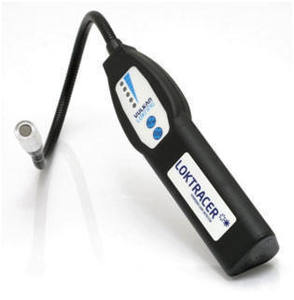Finding Leaks in a Hydrogen Cooled Electrical Generation System

The TLD.500 Loktracer Helium Leak Detector uses a sensing chip that only detects hydrogen gas. The TLD.500 weighs less than 1 lb., is low cost (less than $1000) and is extremely sensitive in detection of hydrogen gas.
Leak Checking the Generator Cooling System
Leaks in the hydrogen cooling system for generators are a natural concern for power-plant workers. Not only are the systems large and complicated, with many joints, seals, packing, etc., but hydrogen leakage is especially hazardous despite the large volumes of the turbine halls.
The TLD.500 Loktracer Hydrogen Leak Detector is sensitive to 100% hydrogen to the single digit ppm levels. Thus leak checking a hydrogen cooled generator is well within its capability.
When searching for hydrogen leakage, one moves the TLD.500 Loktracer to probe around all the potential leak sites, watching the display on the hand piece, or listening to the audible signal through earphones. The response of the leak detector, operating in this manner, is about one second, so the operator can easily pinpoint the source of leakage.
Hydrogen usage should be a guide to the total leakage of the system. For safety reasons, it is important to realize that leakage into a pocket or closed space can easily build to an explosive level. And anyone who has seen a small hydrogen flame “disappear” when lights are turned on knows what a hazard these invisible fires can be. Routine leak testing is so easy with the TLD.500 that there is no reason to put it off.
In recent years a number of authors have addressed the various costs to power plant operators of vacuum leakage. These costs range from the erosion and pitting of turbine “buckets,” through exhausting of condensate polisher resins to simple loss of turbine efficiency, as the condenser vacuum is lost. Other costs can include corrosion of Admiralty-metal tubes by the high levels of hydrazine used to reduce oxidized metals. All of these costs can be reduced (sometimes very drastically) by adequate leak location methods, followed by appropriate repairs.
Assessment of these costs as a function of leak rate is impossible in many cases. (Fractured blades on a turbine disc bear a known cost in parts and downtime, but how much oxygen causes the fracture is not known.) An exception is the loss of turbine generator efficiency at progressively higher base pressures due to in-leakage.

